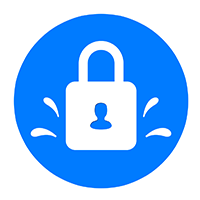Introduction
SplashID provides quick and easy access to all of your personal identification information, including usernames, passwords, credit cards, PINs, calling card numbers, frequent flyer numbers, insurance info, and more. Data is stored in a secure, encrypted, password protected format and can be synchronized between SplashID on your mobile device and SplashID on the desktop (Windows, Mac OS, and web). You may prefer to do most of your data entry on the desktop, however, since it’s faster and easier with a keyboard, and then synchronize that data to your other SplashID apps.
Account Types
SplashID Safe is the only password manager that lets the user choose how to handle the storage of their sensitive records securely. You can choose between Cloud sync, local WiFi sync, or No sync based on your needs.
The web application allows you to view all your records in a browser. This is available for users who are using cloud sync.
SplashID Cloud Services
SplashID Cloud Services provides seamless automatic sync across all your computers and devices via our secure cloud server: anywhere, anytime. It’s the quintessential “set it and forget it” sync solution for secure data.
In addition to automatic sync, the optional SplashID Cloud Services also includes a powerful web-based version of SplashID Safe, professional email support, and automated cloud backups.
Local WiFi Sync Only
This is the familiar WiFi sync solution that has been in SplashID since version 4. You can manually connect and sync SplashID on the mobile device with the PC or macOS desktop SplashID over your local WiFi network.
The web application does not show you any records as they are not present in the cloud for WiFi sync users. You can use the web application for viewing your subscription and setting up a 2-factor for your account.
No Sync Enabled
This option exists for those users who don’t plan on synchronizing their SplashID Safe data. Your data will exist only in the local database on the device, and will not be automatically backed up in the cloud or synchronized with any desktop or web app.
The web application does not show you any records as they are not present in the cloud for No sync users. You can use the web application for viewing your subscription and setting up a 2-factor for your account.
Registration
You can register for a SplashID account at https://www.splashid.com/register. It is recommended that you enter your email address in lowercase during the account creation.
By default, registering for a SplashID account in the browser will set up your account to use SplashID cloud services. You can switch to the other sync modes in the native apps.

If you are residing in the European Union, then you need to provide consent to SplashID to store your information outside the EU region. Please select the appropriate option that is asked for in the account registration screen.
Once you create a SplashID account you can use the same account for access on all your devices and desktops. A SplashID Pro license will be required if you need to access it across unlimited devices and desktops. Please visit https://www.splashid.com/pro to get a SplashID Pro license.
Login
You can access your SplashID account at https://www.splashid.com/login.
If you had created your SplashID account more than 5 years ago, then you should enter your email address exactly as you had set it up initially. For all new users, the email address should be in lowercase.
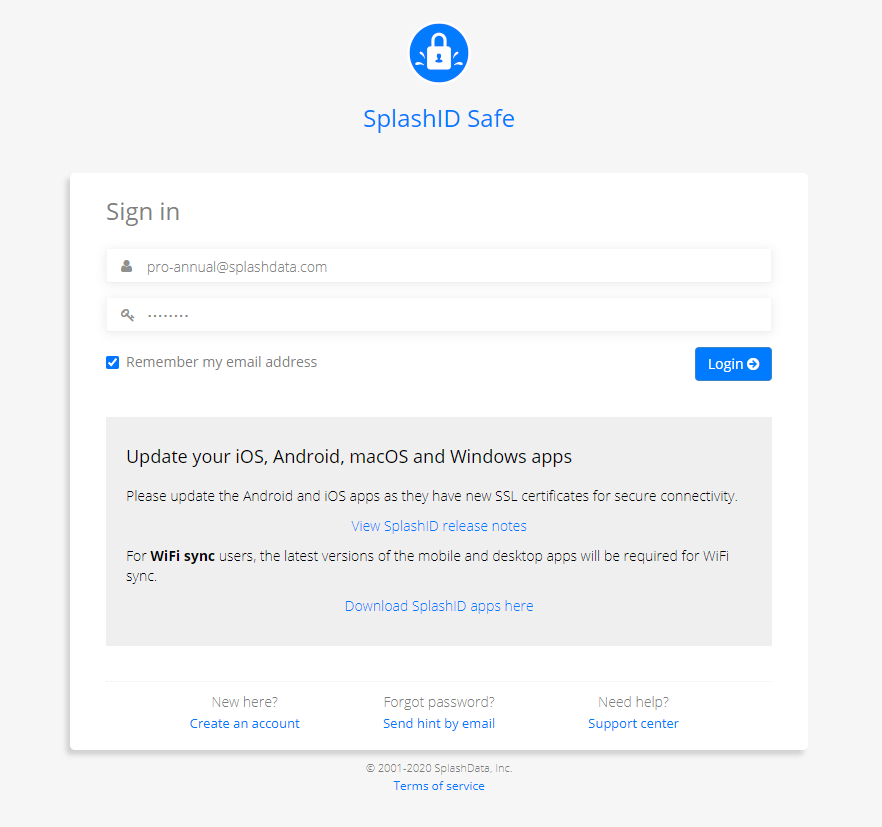
Important information on SplashID updates or issues will be displayed on the login screen.
User Interface
When you access SplashID in a browser you are presented with a 3-panel layout.
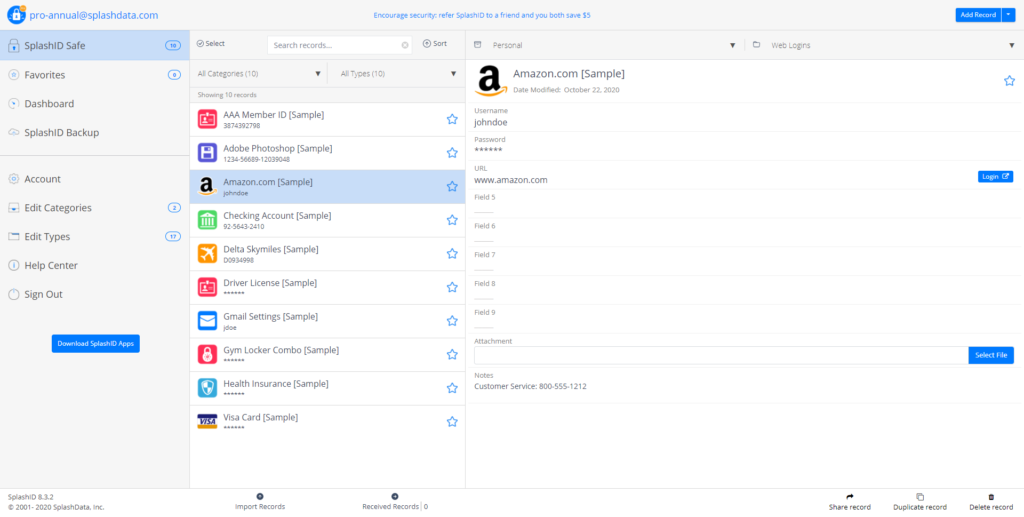
Here’s a breakdown of the different panels in the interface. Click on each heading to expand and see the specific tools.
Side Menu (Left)
The Side Menu is similar to the side menu that slides out on the iOS and Android apps, where you can access the following options:
- SplashID Safe – This is the list of Records, where you can search, view, and edit your secure records.
- Favorites – All your records marked as Favorite are displayed in this view.
- Dashboard – Access the Dashboard, where you can analyze your records and improve your security.
- SplashID Backup – Cloud sync users will be able to access and restore online backups on those rainy days.
- Account – Access all the Account Settings. See the next section for details.
- Edit Categories – Displays the Categories that you can use to group records in. You can edit or delete an existing category, or you can click on the Add Category button to create a new one.
- Edit Types – Displays the Types which you may edit or delete. Select an existing type and click edit, or click Add Type to create a new one.
- Help Center – Access the SplashData Help Desk at support.splashdata.com.
- Sign Out – Signs out of the SplashID web app in the browser.
Record List (Center)
The middle panel is known as the Record List. From here you can browse, search, add, edit, select a record to view its details, delete them, or make them favorite.
Starting from the top left, here are the functions of the Record List:
- Category and Type filters – Select a Category or Type to filter by
- Search – Search on any field with dynamic results
- Select – Brings up an action bar on the bottom of the screen, so you can select multiple records and perform common actions on them. The actions that are available are:
- Select All
- Share
- Export
- Delete
- Change Category
- Change Type
- Sort – Change the records listing view to sort by Name, Type, Category, or Modified Date in ascending or descending sorting order. Click on the arrow icon next to Sort to show the list in an ascending or descending order.
In the normal view, there are two options at the bottom of the middle panel.
Import Records
This option allows you to upload a SVID, vID or CSV file for importing records into your account.
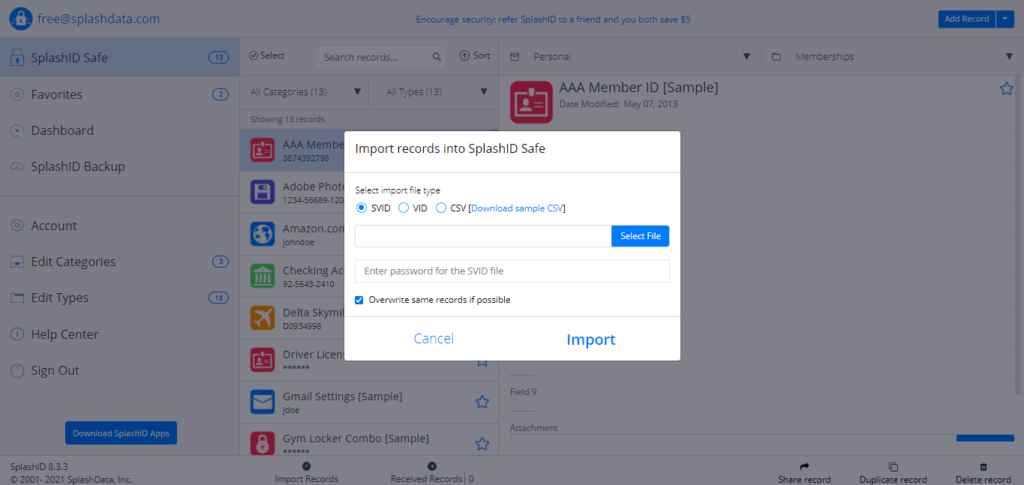
Received Records
If another SplashID user has shared records with you, then you can see the shared records here. It will give you the option to import the shared records into your account or remove them from the received list.
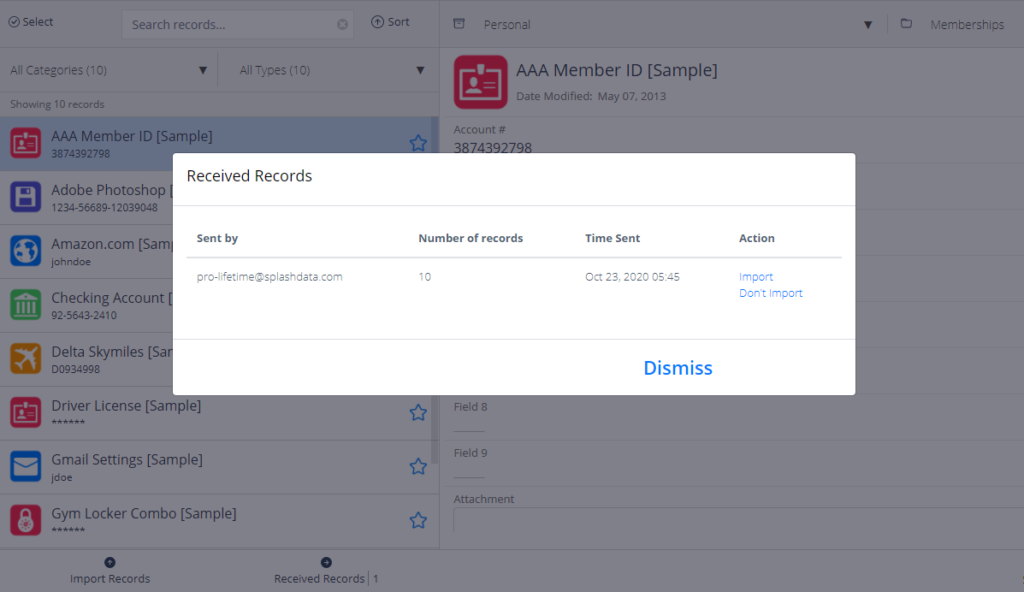
In the record selection view, there are multiple options at the bottom of the middle panel that allow for conveniently operating on a selection of records.
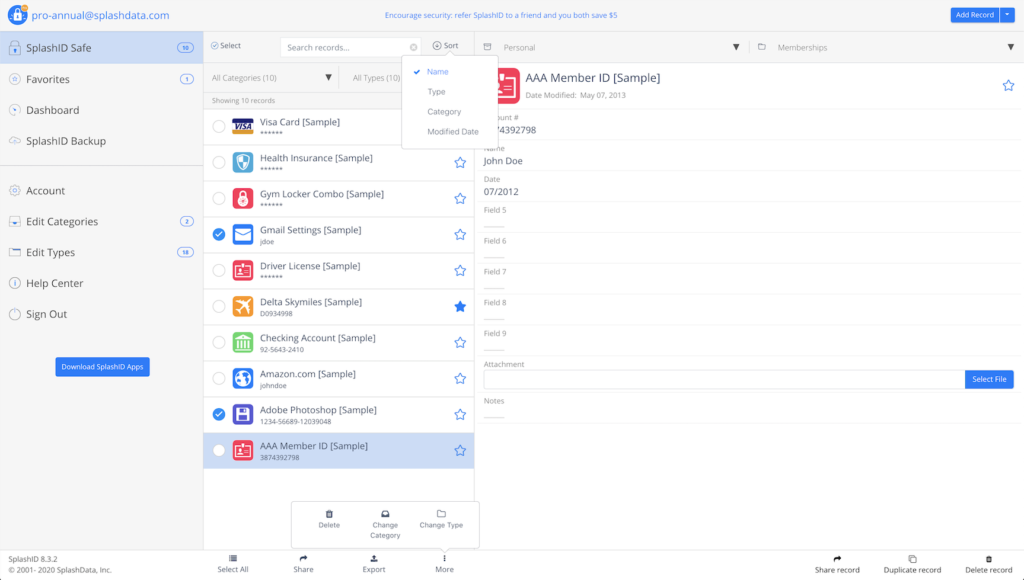
Export Records
One or more records can be selected and then exported to files for your own manual backup. The selected records can be exported to SVID or vID files.
SVID files include user uploaded icons on records and has enhanced user information to allow for updating the records during an import. You can manually export and import SVID files. It is recommended that you use SVID files instead of vID files for the manual export and import of records.
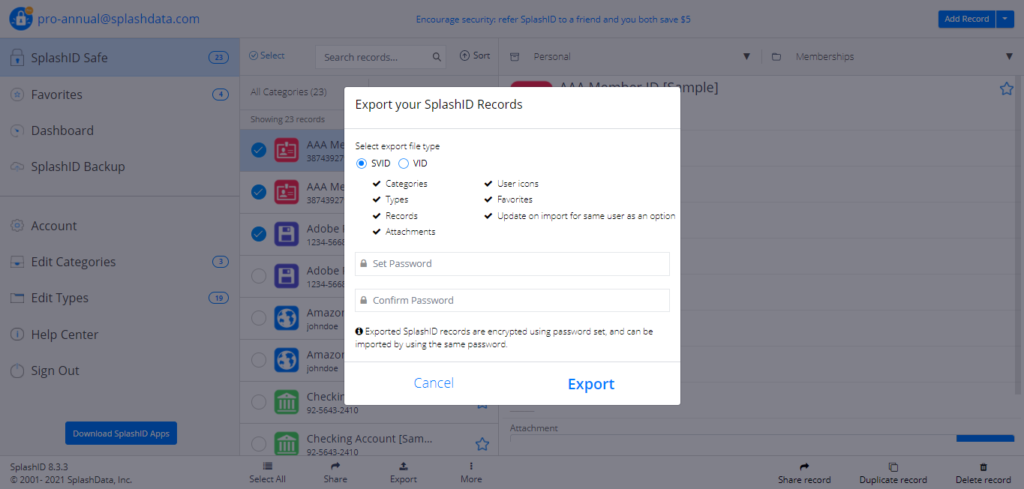
Export selected records to a SVID file.
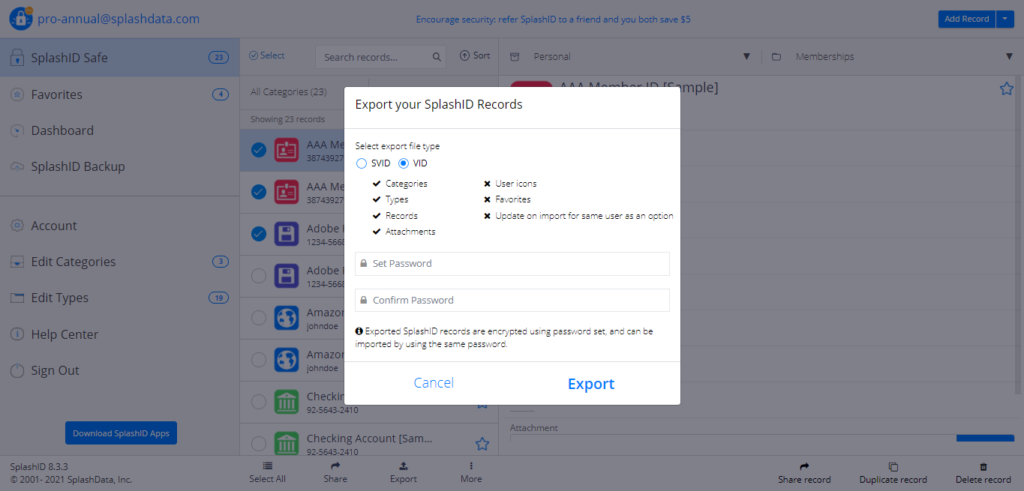
Export selected records to a vID file.
Multiple Delete
You can select one or more records for deletion from the More menu at the bottom of the middle panel.
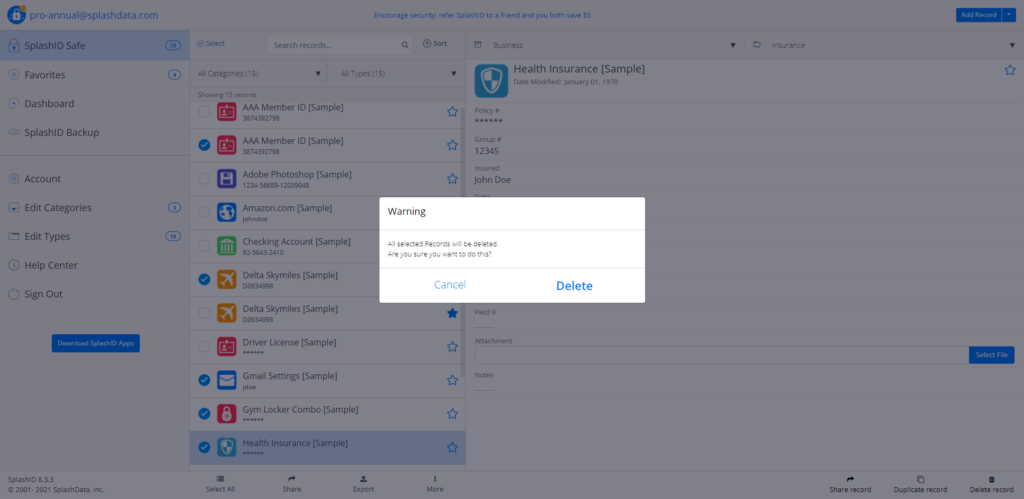
Change Category
If you need to change the category of more than one records, then select these records in the middle panel and then use the Change Category option from the More menu at the bottom of the middle panel.
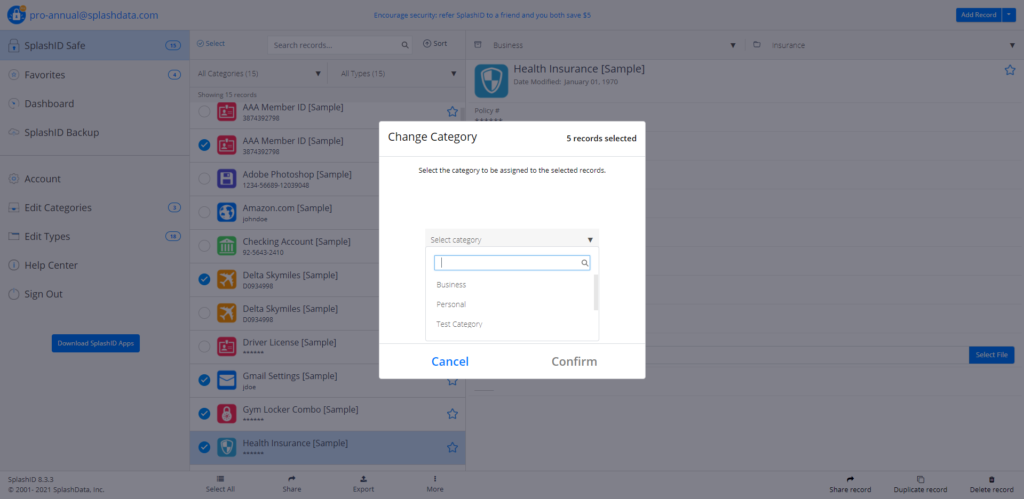
Change Type
The type of one or more records can also be changed from the More options after selecting these records in the middle panel.
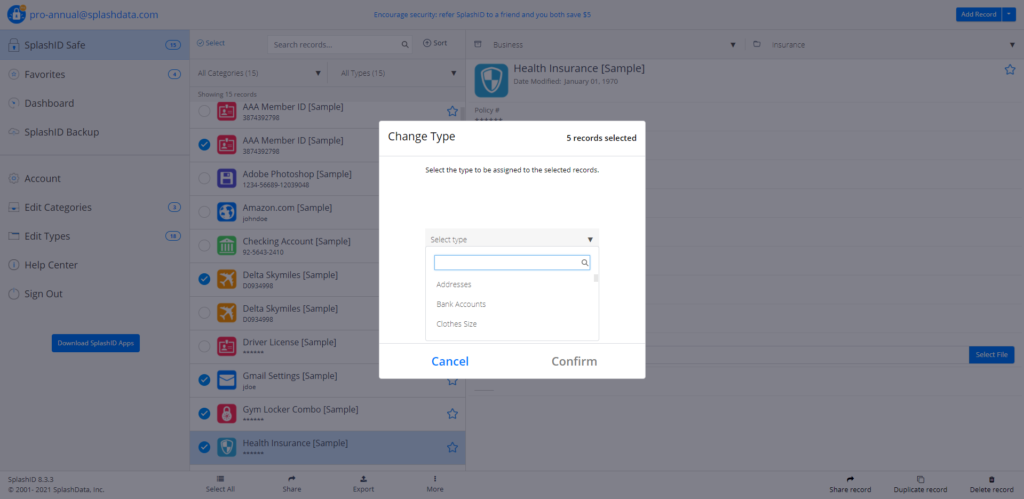
When you click on a record in the Record List, it opens the Record Details on the right panel.
Record Details (Right)
The right panel is for Record Details, which displays the details of the record you select in the Record List.
While viewing a record, click a field and then the Edit button to make changes. We’ve designed this screen to give you everything you need on one level so you don’t have to drill down to make changes. We’ll go into more detail in the Record Details and Editing Records sections below.
Record Details
When you click on a record in the Record List, it opens the Record Details screen. We’ve designed this screen to give you everything you need on one level so you don’t have to drill down to make changes.
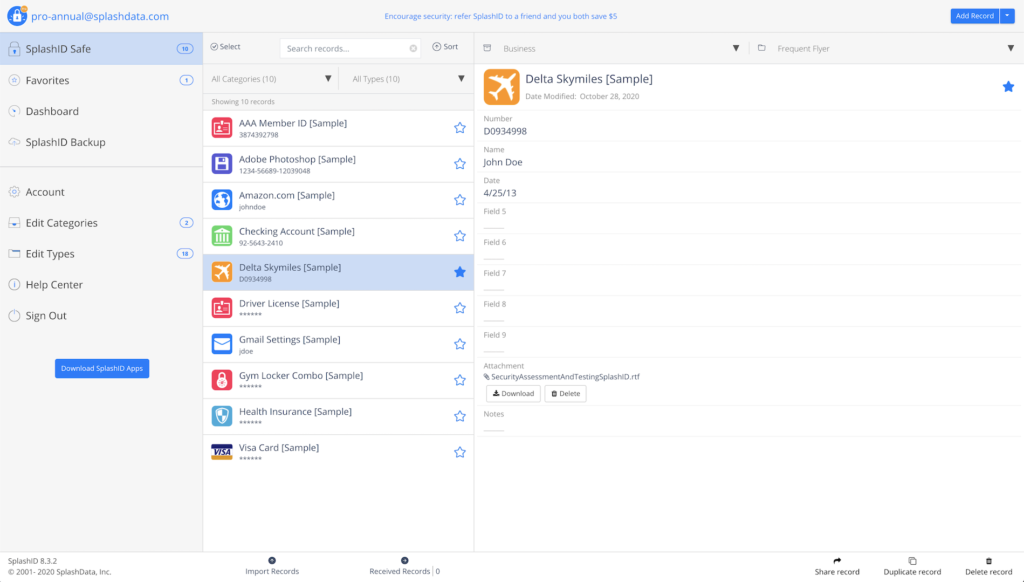
You can make a record a favorite by clicking on the star icon in the record name row in the details.
Click a field to edit it or show the Copy, Generate (password), or Mask options for the field. Once you make changes click on the Save button next to the field.
Click the Login button next to the URL field in a Web Login record to open the browser and autofill the username and password.
Share record will enable you to share the current record with another person.
Duplicate record will make a copy of the current record so you can edit it and save it as a new record.
Delete will delete the current record.
A Custom Icon can be set for a record if you desire to have one. To set a custom icon you can click on the icon next to the record name, and then select an icon from the displayed list or upload a new one by clicking on the Upload icon button at the top right. An uploaded icon can be cropped or rotated as per your needs before you upload it to your account.
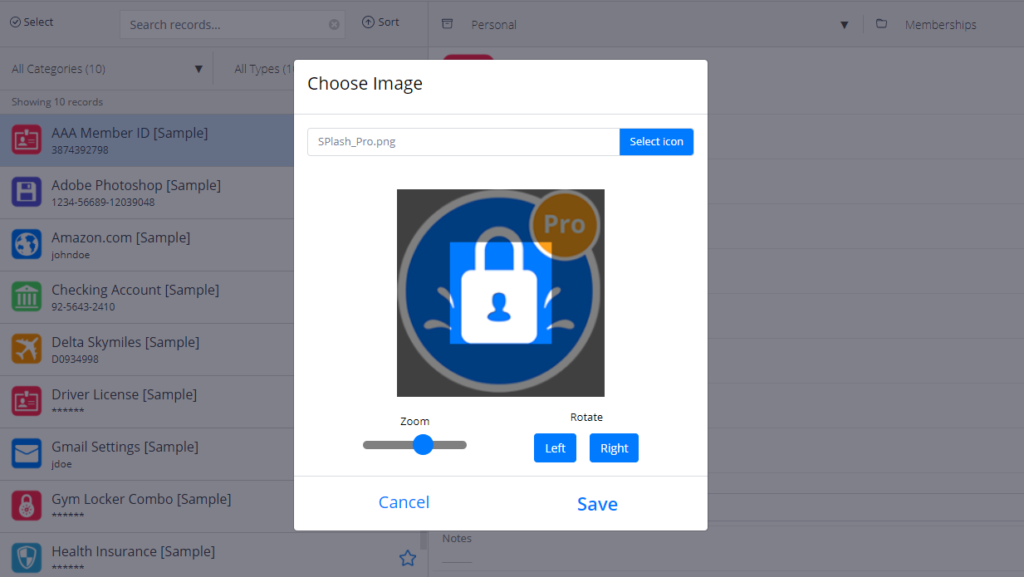
Editing Records
While viewing a record, click a field or field label to make changes. On clicking the New Record button the panel will switch to a blank record view with all fields enabled for editing the record.
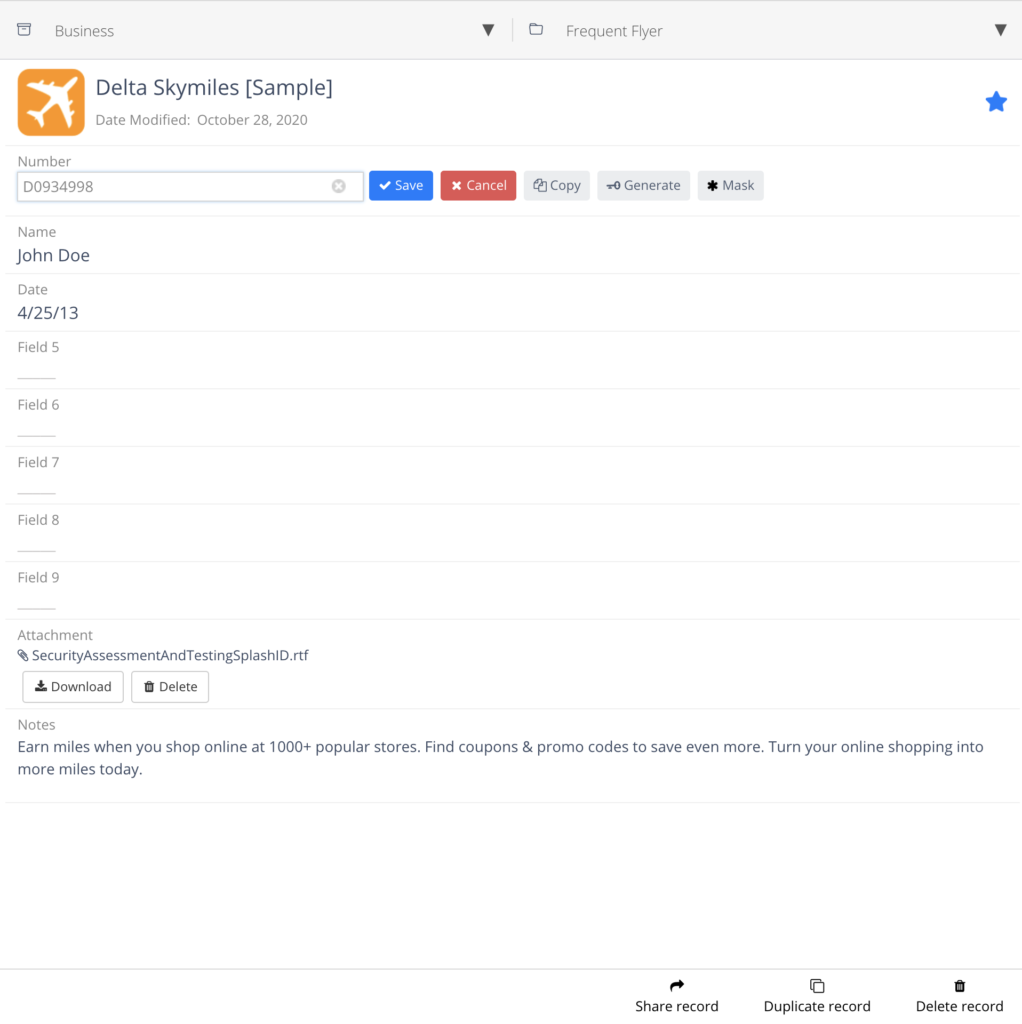
Click the Category or Type menus to change the assigned category or type.
Click the Icon to access the icon picker and make a new selection. This may not be necessary, however, as many logos are automatically assigned after you enter the record name. For example, type “Amazon” for the record name and the Amazon logo shows up when go to the next field or save.
Click the field in the data space or the field label to edit directly. From there you will have some tools:
- Save / Cancel – Save or discard any changes you make
- Copy – Copy the field contents to your clipboard for pasting in other windows
- Generate – Use the password generator to suggest a strong password
- Mask – Set the field to be masked by default. Clicking masked fields will reveal their contents
Use the password generator in the fields to create random and secure passwords. You can configure it with the options that suit your needs.
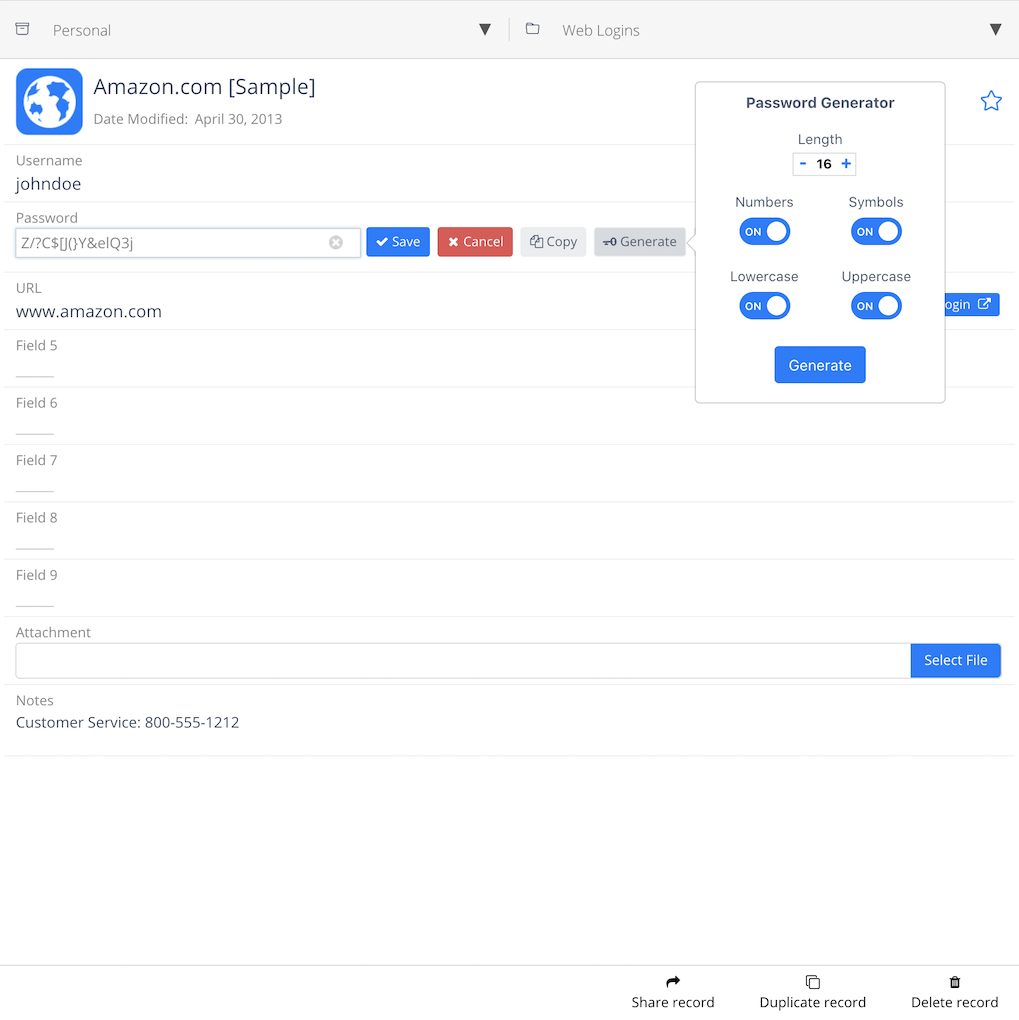
Click the Notes field to add notes up to 4000 characters. The notes field can be used for capturing important details about your record.
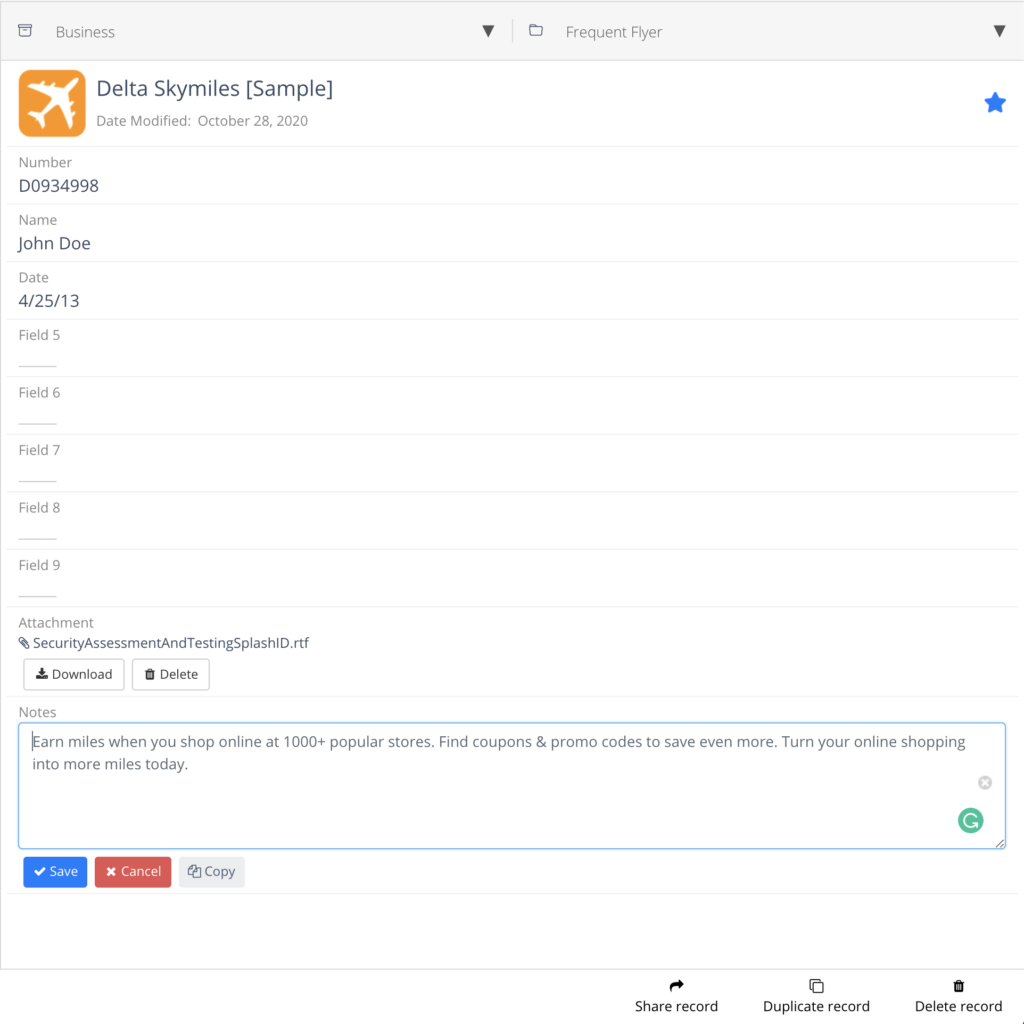
Click Select File in the Attachment field to add a photo or document (up to 1 MB).
Categories & Types
The difference between Categories and Types is best illustrated by an example. You use Categories to group your Business records or your Personal records, while you use Types to identify your Credit Card records from your Web Login records.
Categories are useful for grouping related records. The two predefined Categories are Business and Personal, though you may add more by choosing Edit Categories from the left panel.
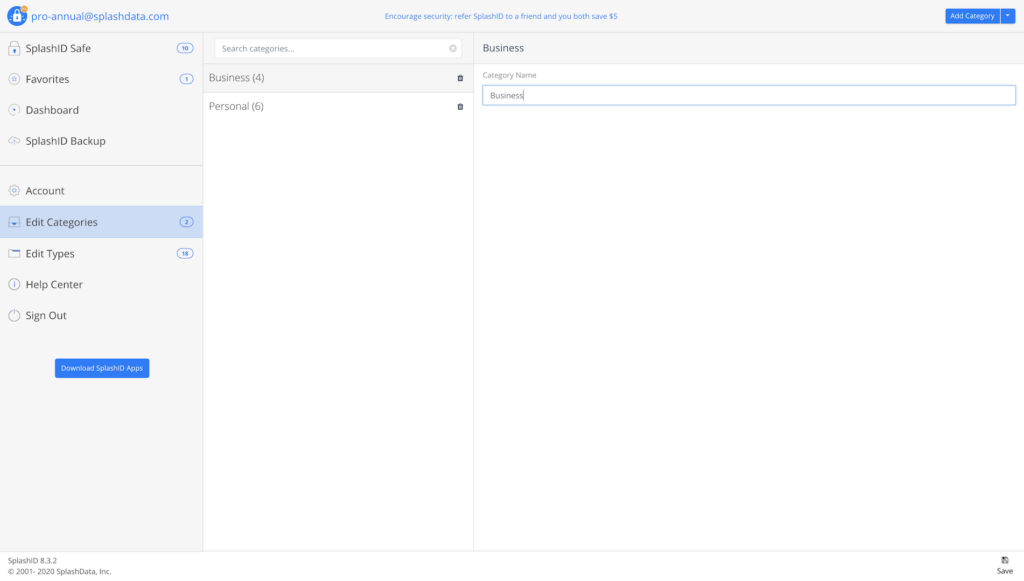
Types act as templates and record identifiers. They define the structure for the items you want to store in SplashID. You may define up to 9 custom field labels and a default icon for each type, as well as specify the fields you wish to mask.
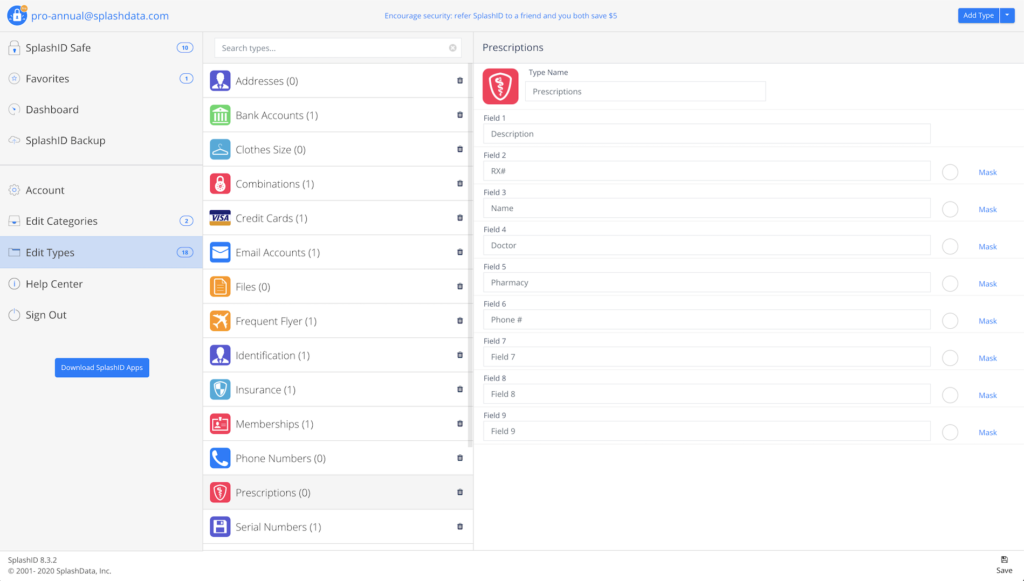
- Edit a type – Click the Edit Types button in the side menu on the left, and then click on a type in the list shown in the middle panel to see the fields in the type. You may create an unlimited number of Types. Several sample types are provided when you first install SplashID for you to use with your records. Select an existing type and click edit, or click Add Type at the top right to create a new one.
- Add a new type – Click on the Add Type button at the top right of your screen to create a new type of your choice. Enter a name for the Type and up to 9 custom field labels. The Mask checkbox specifies whether or not the data in that field will be masked when the record is displayed. You may also specify a default icon for the Type for easy visual cues about your records.
Account Settings
When you click Account on the side menu, you will see the following options.
SplashID Account
- Email – Select to edit the email address you associate with your SplashID account.
- Password – Select to edit the password protecting SplashID. See Security for more info.
- Plan – View your plan details and license status.
Account security
- Application timeout – Set the period of inactivity that must pass before the application locks itself.
- 2-Factor Authentication – 2-factor Authentication is a recommended option to increase the security of your SplashID account. The 2nd factor is an additional code that needs to be entered when your SplashID account is accessed from a new desktop, device, or browser. Once you confirm, access is authorized with the additional code, and you will no longer need to enter the 2nd-factor code when you log in from that device or browser.
Maintenance
- Reset SplashID types and categories – Use this option to recover the original types and categories that had initially come with the account. Any changes made to the SplashID types will get reset to the original types.
- Remove all unused custom icons – Use this option to delete all icons uploaded by you that are not used in the records.
Subscriptions details view – Shows billing history of invoices you have paid on your SplashID Pro account. Provided by our billing service, Recurly.
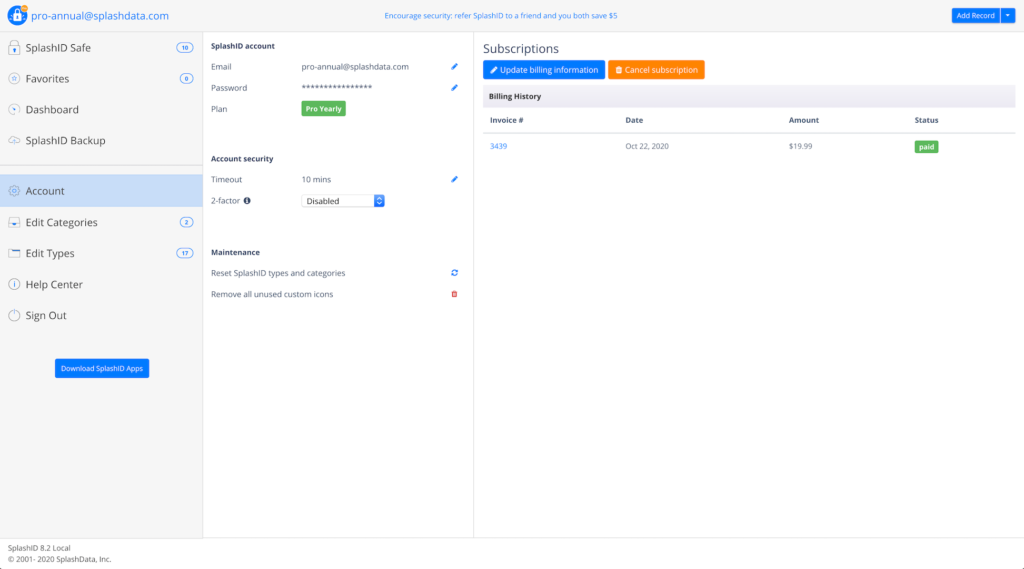
If you do not have a subscription, then you will be presented with options to purchase one. On completing the purchase, you will have access to all the features of SplashID without any restriction on where you can install and use it.
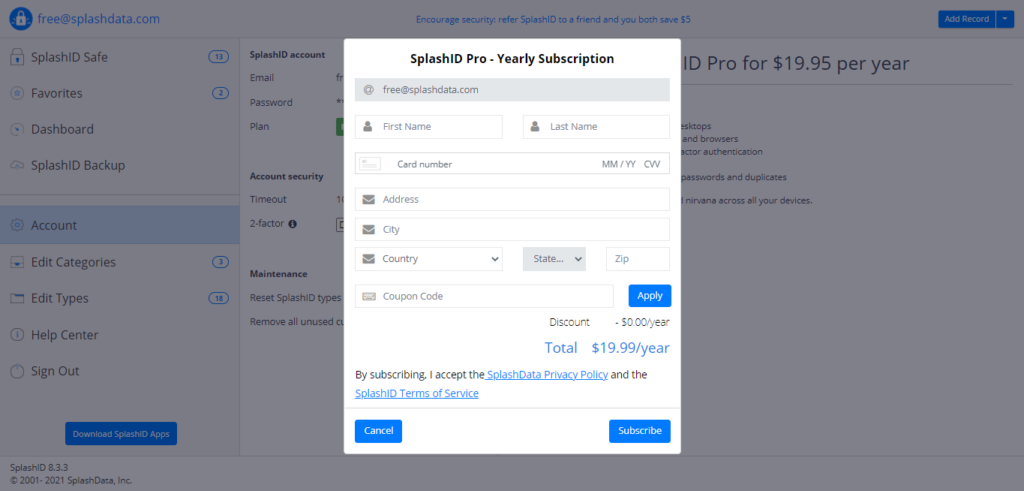
Annual subscription purchase screen
Security
Setting a Password – You must set a strong master password to protect your data. A strong master password can be a long string of characters that only you know. If you are not comfortable, avoid using special characters and spaces, but keep the master password long enough. 16 characters consisting of random numbers and letters will be a good strong one.
Remember this password
Do not forget it ever or you will not be able to sign in to your account.
You will need to use this same master password to open SplashID on all your devices and desktops.
- Your password must be at least 4 characters in length.
- The master password is case sensitive.
- A strong master password of at least 8 characters including at least one number, one upper case character, and one non-alphanumeric character is strongly recommended.
- Once you set a password, SplashID encrypts your data using 256-bit Blowfish encryption to ensure data security.
Password Hint
You should always enter a hint to remind you of your master password if you forget it. The password hint will be sent by email when you request it. Please do not use your password as it is in a hint, but add some clues that will help you remember your master password.
Test your password hint once you set it
Sign out of your account and in the login screen, and click on the Send hint by email link at the bottom of the login form to get your password hint by email.
Entering a Password
You will be required to enter your password each time you access SplashID in a browser.
Changing a Password
To change a password, select Change Password from the Account menu, enter your Old Password, then enter and confirm the New Password.
Once you change the password, quit SplashID on all your devices and desktops and sign in again to make the password change effective across all. If not done correctly on all your devices and desktop this can corrupt the data in your account.
2-Factor Authentication
2-factor Authentication is a recommended option to increase the security of your SplashID account. The 2nd factor is an additional code that needs to be entered when your SplashID account is accessed from a new desktop, device, or browser. Once you confirm, access is authorized with the additional code, and you will no longer need to enter the 2nd-factor code when you log in from that device or browser.
To use 2-Factor Authentication, login to your SplashID account in a browser. Under Account > Account security > 2-factor, select ‘Enabled by email’ or ‘Enabled by SMS’.
Once enabled, if you attempt to log in to your SplashID account from a new browser, desktop, tablet, or phone, you will be required to enter a 6-digit code that is emailed to your SplashID account email or that is sent by SMS to your phone. Once you enter the second-factor code, you should never be asked for the code again on that browser or device. If you want to authorize access on another new browser or device, you will need another second-factor authorization code sent.
2-Factor by SMS needs you to not have any blocks on SMS receiving with your phone service provider.
Backup & Restore
With SplashID 8, cloud sync users have a new backup service that protects them from data loss forever. Every week, a new encrypted backup is automatically created for you. Your 5 most recent backups are available anytime to download or restore as your current database. And you can lock in any backup (or your current database) as your master backup.
Hopefully you’ll never need to use it, but if you do, here’s how.
Login to any SplashID 8 client app – iOS, Android, Mac, Windows, or Web – and select the SplashID Backup tab on the side menu.
To restore a backup, select the backup you would like to restore, based on the date and number of records it contains, then click Restore.
You can also make your current database the “master” backup, by clicking the check mark in the first control that displays Make my current database as master backup. The master backup never gets overwritten by newer backups, giving you a reliable restore point once you set it. If you want to release the master backup, click the Unlock button. Or you can just replace the current master backup with your previous backup at any time by using the Make Master button in the list of weekly backups again.
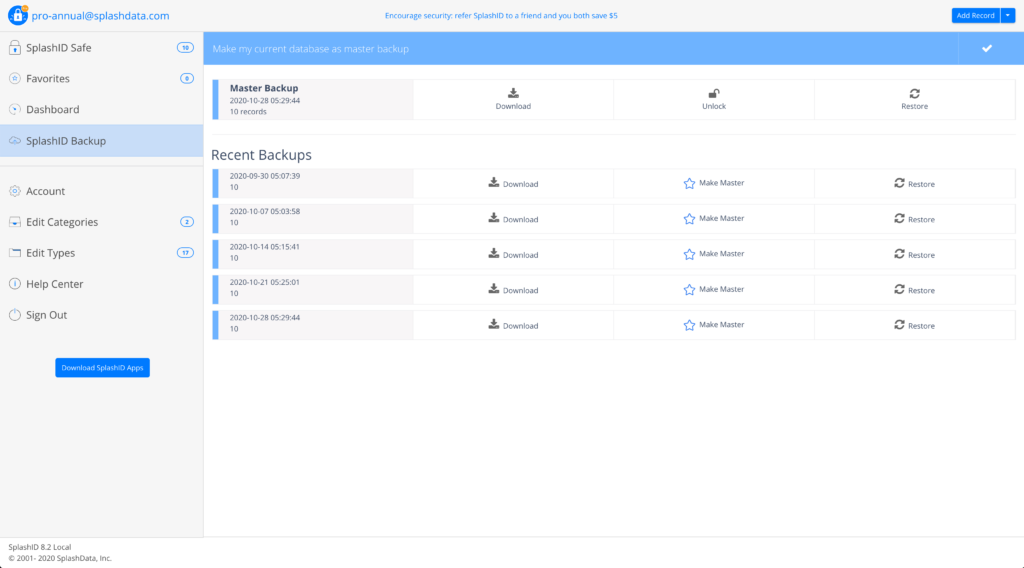
Using the Download button you can get a copy of the backup in vID file format for manually keeping a backup in your system.
Dashboard
The graph shows you the overall growth of your SplashID database over time, and under that you will find a table indicating the total number of categories, types, and records in your database.
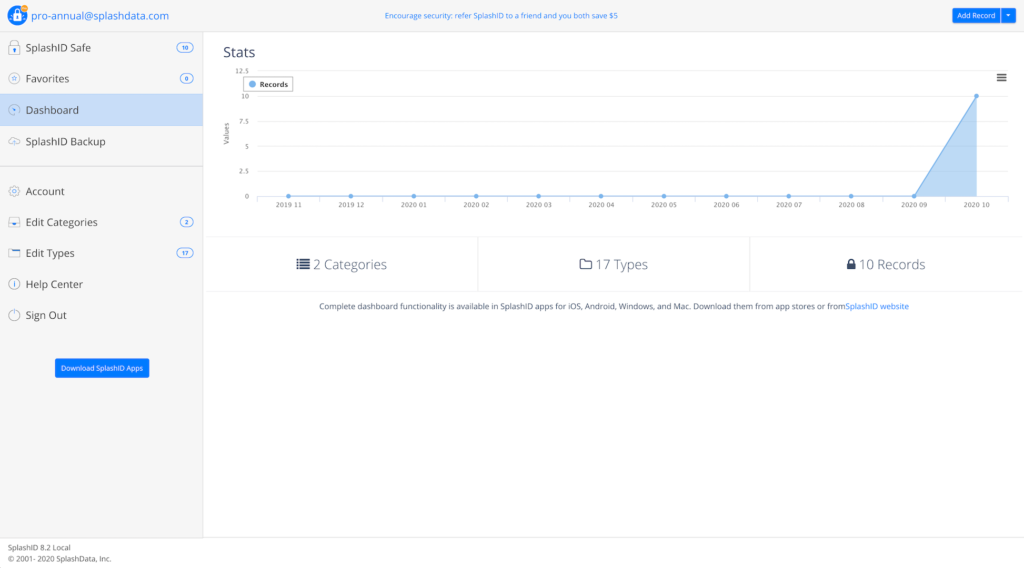
Getting Support
SplashData offers technical support and other resources online. SplashID Safe support is customized to meet your needs. Please go to https://www.splashid.com/support to get help on an issue by our experts, or visit our support center at https://support.splashdata.com for useful information on commonly occurring issues that can be resolved by yourself.
You can view knowledge base articles, ask public questions, and contact customer support to get the answers you need.
App Updates
The web application is updated on our servers regularly. You do not need to install anything to get the latest web application. You might need to clear your cache and cookies to get the latest SplashID web application files in your browser.
The native SplashID apps for Android, iOS/iPadOS, macOS, and Windows are also available. Please visit https://www.splashid.com/downloads for more details.
To study the release notes you can visit our page at https://www.splashid.com/release-notes.
